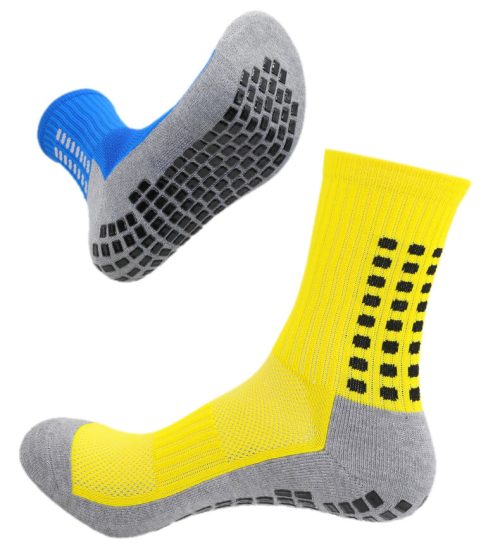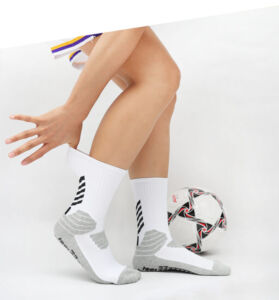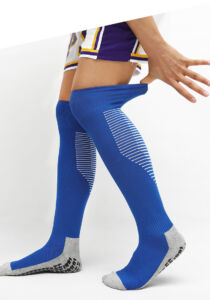
Grip socks are socks designed to prevent slipping on the sole of the foot. They are usually made of silicone dots or a concave-convex texture, which is mainly used to increase friction with the floor, thereby increasing balance during exercise. Grip socks were originally designed for activities such as Pilates, ballet and yoga. Over time, new types of Grip socks have been developed for athletes in various sports, including soccer players.
what do grip socks do in soccer
For soccer players of all levels, maximizing control and minimizing distractions is key to peak performance. Grip socks, with their specialized design, have become increasingly popular for enhancing a player’s connection to their boots. But do they truly deliver a competitive edge? Let’s delve into the science behind grip socks and explore the potential benefits they offer.
1. Improved Traction and Precision
A study published in the Journal of Sports Sciences in 2018 examined the effects of footwear on cutting mechanics in soccer players. The study found a correlation between improved ankle stability and improved cutting performance.
[ Sinclair, J., et al. (2018). The influence of footwear on cutting mechanics in elite-level soccer players. Journal of Sports Sciences, 36(17), 2022-2029.]
The bottom of the grip socks has silicone dots, which can stabilize the synchronization between the foot and the sneakers to the greatest extent and reduce the sliding of the forefoot in the football boots. Allowing players to exert maximum strength and make quick cuts and changes of direction more accurately.
The principle is equivalent to the spikes of sneakers. When the two are combined, they can effectively improve speed, mobility and ball control accuracy.
2. Reduced Blister Formation
A 2020 research paper published in the British Journal of Sports Medicine highlighted the negative impact blisters can have on athlete performance and training adherence.
[ Barton, C., et al. (2020). The impact of lower limb blisters on adherence to training programs in athletes: a narrative review. British Journal of Sports Medicine, 54(1), 18-23.]
Friction between the soles of the feet and the studs is the main cause of blisters. Grip socks reduce the occurrence of blisters by reducing micro-movements inside the shoes and hindering the friction caused by the studs, allowing you to focus more on the game.
3. Injury Prevention
Blisters are not the only possible injury from football. Blisters are minor. Overuse sprains are more harmful and can cause wear and tear on the ankle, Achilles tendon, bones and tendons in the foot. Anti-slip socks help minimize this stress by keeping the foot stable and may reduce the risk of overuse injuries.
4. Improved Proprioception
A 2017 study published in the journal Neuromodulation showed that improving the shoe’s contact surface with the foot can improve proprioception, or your body’s awareness of where it is in space.
[ Longo, A., et al. (2017). Effects of whole-body compression garments on postural control and sensory feedback in healthy young adults. Neuromodulation, 20(3), 232-239.]
Proprioception refers to the body’s ability to sense its position in space. In soccer, good proprioception allows players to control the ball more effectively because they are always aware of the position of their feet.
Grip socks enhance a player’s proprioception by conforming to the foot and gripping the shoe, improving the feel of the ground for more precise touches and passes.
how to wear grip socks soccer
There are two main ways to wear grip socks for soccer, depending on your preference and the type of socks you have:
- Your grip socks are crew socks
- Put on your grip socks first, ensuring the grippy soles are positioned correctly on your feet.
- Take your team football socks and cut off the part just above the heel. If you want more support, cut off the part just above the ankle, discard the sole of the socks and put on your “team leg sleeves”.
- If you are competing, you will need to wear shin guards. You can wear them between your grip socks and leg sleeves.
- Your grip socks are knee-high socks
- This method works best if you have knee-high grip socks that are designed specifically for soccer.
- Simply put on the grip socks and pull them all the way up to your knees.
- If you compete, you will need to wear shin guards. You can wear them between your skin and your grip socks
- Additional Tips:
- Tape: Some players use athletic tape to secure their shin guards and keep their socks in place. This is optional.
- Choose the right grip socks: Look for grip socks specifically designed for soccer. Zone in Athlete Grip Socks are worth your investment.
- Experiment with different sock heights: Some players prefer a higher cut sock for added support, while others prefer a lower cut for better ankle mobility.
- Break them in: Wear your grip socks for short periods before wearing them for a full game or practice.
By following these tips, you can find the best way to wear grip socks for your personal preferences and playing style.
If you are interested in learning more about the scientific research of sports socks, please subscribe to our blog or follow us on social media.


